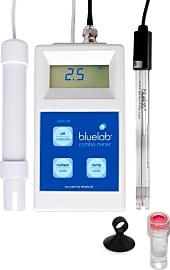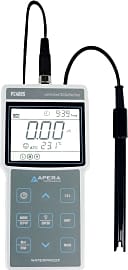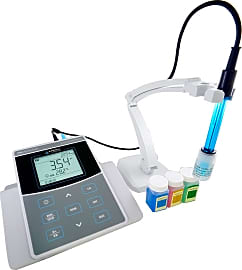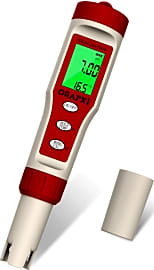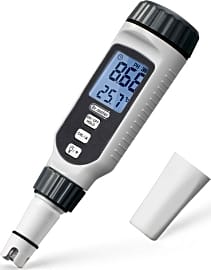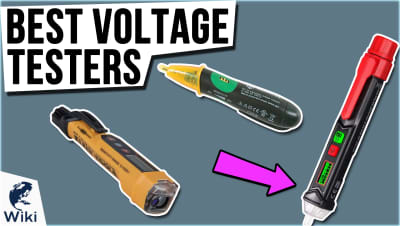The 10 Best pH Testers

This wiki has been updated 43 times since it was first published in July of 2015. For horticulturalists, pool owners and home brewers, knowing the pH levels of your water is vital to getting the results you're looking for. These testers offer a vast range of applications, and some even double as digital thermometers or electrical conductivity gauges. Our selection of meters includes something for most possible uses, at a range of prices to suit home users and professionals. When users buy our independently chosen editorial recommendations, we may earn commissions to help fund the Wiki.
Editor's Notes
November 05, 2020:
Our rankings may not look all that different after this round of updates, but in fact, we did switch out a number of our selections for new, but very similar models that come with additional bells and whistles. For example, the Dr. Meter PH100 was replaced by the Dr. Meter PH838 — which appears to be quite close to the same offering, only with a two-tone, backlit LCD that flashes red any time a dangerous reading is taken.
Similarly, the Apera Instruments SX610 gave its spot up to the Apera Instruments SX620, which is available for virtually the same price as the SX610, but distinguishes itself with a three-point calibration system that helps improve its accuracy when testing highly acidic or alkaline samples. However, it’s worth noting that this calibration process can be quite inconvenient, when compared to the auto-calibrating alternative, so users who are primarily tracking samples that are fairly neutral might still be best served by the SX610.
The Risantec Digital was eliminated to make room for some higher-end choices – like the Bluelab PENPH, which features a handy wrist strap and a double junction probe – and we also added the Orapxi 4 in 1 to our list — an alternative budget pick that does still cost considerably more than the Digital, but blows it out of the water with its ability to test total dissolved solids and conductivity.
We also replaced the Apera Instruments PH700 with the Apera Instruments AI423 PC400S — a formidable fieldpiece that can store 1,000 data sets and measure all the same values as the company’s 5-in-1 PC60. And, our last new addition this time around was the Apera Instruments PC800 — a benchtop model that's designed for long-term laboratory use.
Although the Apera Instruments PC60-Z has a probe for solids that can be purchased separately, it's important to note that these rankings are focused on options intended for liquid testing. If that isn't what you're after, we also maintain a separate page for soil testers, which make it easy to directly test your growing medium.
November 15, 2019:
During this round of updates, we removed the Diliss 001 and 7Pros pH Pen – due to availability issues, as well as the Covery 3-in-1 – which still might be an alright suggestion for monitoring a house plant’s soil, but struck us as being an unreasonable choice for our mix of best possible products in this category. At the same time, we’ve included two additional offerings from Apera in our rankings – a company that continues to impress us with their lab-grade testing equipment.
The Apera Instruments PH700 got our attention with its handy electrode clamp, which keeps hold of your probe and gives you back the use of your second hand during testing. This model also has a small internal hard drive which can store up to 50 data groups for further reference.
Although it costs considerably more than most of the options we ranked, the Apera Instruments PC60-Z takes data collection even further than the PH700, and can connect via Bluetooth to any Apple or Android device, offering cloud storage for your test results, and enabling you to further process them into helpful tables and graphs.
What Exactly Is pH And How Is It Measured?
All other measurements are based against the 7.0 neutral standard.
pH is a measurement of the relative amount of hydroxyl and free hydrogen molecules in a liquid. Liquids with higher levels of hydroxyl are considered basic or alkaline, while a liquid that has a higher level of free hydrogen ions is considered acidic. Pure water at 25 degrees Celsius has a pH of 7.0 and is considered neutral. This means it has an equal amount of hydroxyl and free hydrogen atoms. All other measurements are based against the 7.0 neutral standard. Acids and bases can be used to counteract each other in a liquid until a neutral balance is achieved.
The pH scale ranges from 0.0 to 14.0. The lower the measurement, the more acidic a solution, and the higher the measurement, the more alkaline. A measurement of 6.0, would be considered slightly acidic, while a measurement of 2.0 would be considered extremely acidic. The best way of comparing acid in a solution is by finding out "how many times as acidic" one liquid is versus the other. The easiest way to do this is by using a logarithm. The pH scale is based on a logarithm that gives us a standard for how many times as acidic a solution is against neutral. Each 1 point step up means a liquid is 10 times more alkaline, and each 1 point step down means a liquid is 10 times more acidic.
Temperature can also play a role in pH measurements. At warmer temperatures, a neutral pH will be lower than 7.0. This is because the forward reaction of the autodissociation of water is endothermically favored and the rate of ionization in water increases at warmer temperatures. The increased rate of ionization increases the concentration of hydrogen atoms, which decreases the pH level. This means that at 40 degrees Celsius, a neutral pH level would be 6.77 instead of 7.0.
The Importance Of pH
Whether we are looking at pH levels in relation to plant growth or upkeeping an aquarium, the optimal level can be the difference between success or failure.
In aquariums, maintaining the proper pH range can help your fish thrive.
In agricultural applications, pH levels will affect everything from root development and the availability of usable nutrients in a growing medium to the prevention of fungi growth and plant disease. While many plants can survive in a variety of conditions and some plants may thrive in more acidic or more basic soils, the majority of plants prefer a neutral to slightly acidic growing medium. The ideal range for most plants is between 6.0 and 6.5. When growing mediums are highly acidic, manganese and and aluminum levels can become toxic to a plant. At levels of 7.0 or higher, minerals like magnesium, phosphorus and calcium can become unavailable.
In aquariums, maintaining the proper pH range can help your fish thrive. If you have a saltwater aquarium, a slightly alkaline water in the 8.1 to 8.4 range can offer your fish a natural antiseptic effect and help them resist bacteria and illnesses. It can also slow down the rate at which coral calcifies. Observing changes in your water's pH can even give you an early warning sign that your marine environment is undergoing other dangerous changes.
Common Methods For Measuring pH
There are three main methods for measuring the pH of a solution: the hydrogen paper method, the colorimetric method, and the electrode method.
Unfortunately, while it can tell us if a solution is acidic or basic, it doesn't give us a precise numerical measurement.
The hydrogen paper method relies on special type of test paper called litmus paper. Litmus paper is a simple filter paper that has been treated with a mixture of natural dyes derived from a variety of lichens. These dyes change color in response to exposure to acidic and basic solutions, typically red when exposed to acid and blue when exposed to a base. The hydrogen paper method is the oldest form of testing pH levels and litmus has been used as far back as 1300 AD. Unfortunately, while it can tell us if a solution is acidic or basic, it doesn't give us a precise numerical measurement.
The colorimetric method is similar to the hydrogen paper method as it uses the natural color changing reaction of chemicals when exposed to acids and bases to determine pH levels. In this case, indicator reagents like phenol red and bromthymol blue are used to produce the color. Instead of dipping a piece of paper into the solution and having the paper change color as with the hydrogen paper method, these indicator reagents are dropped into a small sampling of the liquid to be measured, and the sample changes color. It is slightly more precise than the hydrogen paper method as the liquid's color and intensity can be compared to a color graph to obtain a numerical pH level.
Currently the most common and most accurate way for measuring pH in home and laboratory settings is the electrode method. This method makes use of a probe and a meter, which must be calibrated before use in a pH buffer solution. The meter measures minuscule voltage differences between a reference electrode and the measuring electrode, and then converts these measurements into a numerical pH reading.


